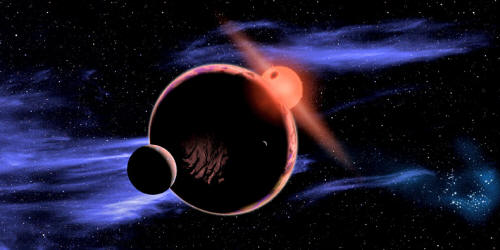|

February 6, 2013
from
USAToday Website

Cambridge, MA
Using publicly available data from
NASA's
Kepler space telescope, astronomers
at the Harvard-Smithsonian Center for Astrophysics (CfA) have
found that six percent of
red dwarf stars have habitable,
Earth-sized planets.
Since red dwarfs are the most common
stars in our galaxy, the closest Earth-like planet could be just 13
light-years away.
"We thought we would have to search
vast distances to find an Earth-like planet. Now we realize
another Earth is probably in our own backyard, waiting to be
spotted," said Harvard astronomer and lead author Courtney
Dressing (CfA).
Dressing presented her findings today
in a press conference at the
Harvard-Smithsonian Center for Astrophysics in Cambridge, Mass.
Red dwarf stars are smaller, cooler, and fainter than our Sun. An
average red dwarf is only one-third as large and one-thousandth as
bright as the Sun. From Earth, no red dwarf is visible to the naked
eye.
Despite their dimness, these stars are good places to look for
Earth-like planets. Red dwarfs make up three out of every four stars
in our galaxy for a total of at least 75 billion. The signal of a
transiting planet is larger since the star itself is smaller, so an
Earth-sized world blocks more of the star's disk. And since a planet
has to orbit a cool star closer in order to be in the habitable
zone, it's more likely to transit from our point of view.
Dressing culled the Kepler catalog of 158,000 target stars to
identify all the red dwarfs. She then reanalyzed those stars to
calculate more accurate sizes and temperatures. She found that
almost all of those stars were smaller and cooler than previously
thought.
Since the size of a transiting planet is determined relative to the
star size, based on how much of the star's disk the planet covers,
shrinking the star shrinks the planet. And a cooler star will have a
tighter habitable zone.
Dressing identified 95 planetary candidates orbiting red dwarf
stars. This implied that at least 60 percent of such stars have
planets smaller than Neptune. However, most weren't quite the right
size or temperature to be considered truly Earth-like.
Three planetary candidates were both
warm and approximately Earth-sized.
Statistically, this means that six
percent of all red dwarf stars should have an Earth-like planet.
"We now know the rate of occurrence
of habitable planets around the most common stars in our
galaxy," said co-author David Charbonneau (CfA). "That rate
implies that it will be significantly easier to search
for life beyond the solar system than we previously thought."
Our Sun is surrounded by a swarm of red
dwarf stars.
About 75 percent of the closest stars
are red dwarfs. Since 6 percent of those should host habitable
planets, the closest Earth-like world is likely to be just 13
light-years away.
Locating nearby, Earth-like worlds may require a dedicated small
space telescope, or a large network of ground-based telescopes.
Follow-up studies with instruments like the
Giant Magellan Telescope and
James Webb Space Telescope could
tell us whether any warm, transiting planets have an atmosphere and
further probe its chemistry.
Such a world would be different from our own.
Orbiting so close to its star, the
planet would probably be tidally locked. However, that doesn't
prohibit life since a reasonably thick atmosphere or deep ocean
could transport heat around the planet. And while young red dwarf
stars emit strong flares of ultraviolet light, an atmosphere could
protect life on the planet's surface.
In fact, such stresses could help life
to evolve.
"You don't need an Earth clone to
have life," said Dressing.
Since red dwarf stars live much longer
than Sun-like stars, this discovery raises the interesting
possibility that life on such a planet would be much older and more
evolved than life on Earth.
"We might find an Earth that's 10
billion years old," speculated Charbonneau.
The three habitable-zone planetary
candidates
identified in this study are,
-
Kepler Object of Interest (KOI)
1422.02, which is 90 percent the size of Earth in a 20-day
orbit
-
KOI 2626.01, 1.4 times the size
of Earth in a 38-day orbit
-
KOI 854.01, 1.7 times the size
of Earth in a 56-day orbit
All three are located about 300 to 600
light-years away and orbit stars with temperatures between 5,700 and
5,900 degrees Fahrenheit. (For comparison, our Sun's surface is
10,000 degrees F.)
These results were published in The Astrophysical Journal, "The
Occurrence Rate of Small Planets Around Small Stars".
Headquartered in Cambridge, Mass., the Harvard-Smithsonian Center
for Astrophysics (CfA) is a joint collaboration between the
Smithsonian Astrophysical Observatory and the Harvard College
Observatory.
CfA scientists, organized into six
research divisions, study the origin, evolution and ultimate fate of
the universe.
For more information, contact:
David A. Aguilar
Director of Public Affairs
Harvard-Smithsonian Center for Astrophysics
617-495-7462
daguilar@cfa.harvard.edu
Christine Pulliam
Public Affairs Specialist
Harvard-Smithsonian Center for Astrophysics
617-495-7463
cpulliam@cfa.harvard.edu.
|

